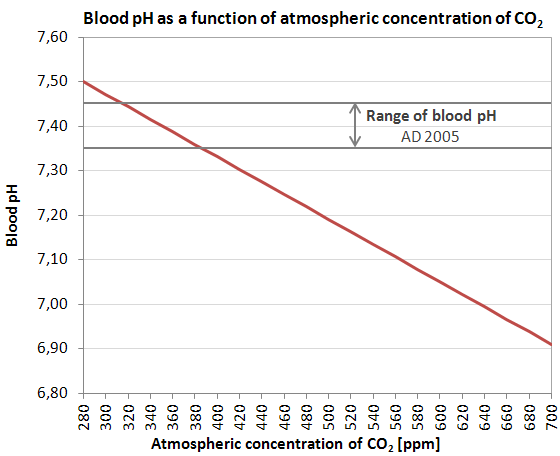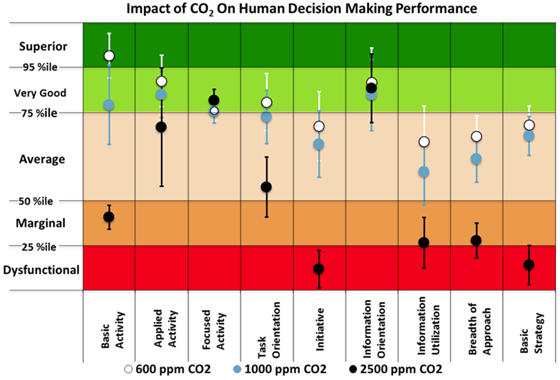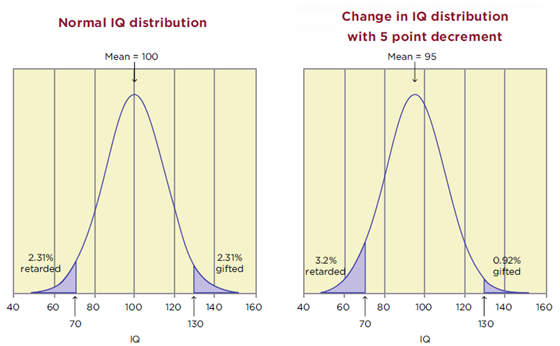
Editorial note
Reader comments elicited by this article call attention to several problems with the path taken to arrive at its central conjecture. We appreciate this feedback and note:
1. The author's key support for claims (cited as "D. Robertson, 2006") is not available.
2. Research results on cognitive effects of CO2 are quite complicated and often inconsistent, insufficiently conveyed here. This leads readers to conclusions lacking circumspect informational foundations.
In the interest of transparency we're not altering the original text. We urge readers to pay attention to the above items of concern which together call into serious question the article's core hypothesis, which can fairly be described as overstated and under-supported.
Did you ever experience being at a lecture or a meeting in a room where you felt tired, your eyes were closing and no matter how hard you tried you could not concentrate? The reason did not have to be a boring subject or a mediocre lecturer – it is a common experience caused by high concentration of carbon dioxide in the air of a crowded and poorly ventilated conference room or a classroom.
People exhale carbon dioxide. If the room is crowded, small and poorly ventilated, the concentration of carbon dioxide in the air grows. When in turn we inhale such air, the carbon dioxide contained in it gets dissolved in our blood and reacts with water to create carbonic acid [H2CO3], which, in turn dissolves into ions of hydrogen [H+] and bicarbonate [HCO3−]. Increase in the concentration of hydrogen ions increases blood acidity and creates electrolyte imbalance, causing increased discomfort and decline in intellectual performance. We feel tired, numb and less capable of any mental or physical effort.

Figure 1. Changes in blood acidity level (pH coefficient) as a function of CO2 concentration in the air we breathe (expressed in number of CO2 molecules per million - ppm). Increase of CO2 concentration in the atmosphere from 280 ppm in the preindustrial era to the current approximately 400 ppm reduces pH of our blood by 0.1 (which is equivalent to acidity increase by 30%). Effective ventilation of buildings becomes more difficult (D. Robertson, 2006).
Building norms are supposed to prevent problems related to poor ventilation. 5000 ppm during an 8-hour workday is typically considered to be the safety threshold. However staying below this level should not be equated with guaranteed comfort and lack of health effects. People start complain about the air quality around 600-800 ppm and the number of complaints greatly increases above 1000 ppm. Various international norms suggest 600 ppm as a maximum CO2 level for a very good air quality, 600 to 1000 ppm is considered good air quality and 1000-1400 ppm is regarded as acceptable (EN 13779, CDC, IDPH, IAQUK, OSHA, EngineeringToolBox). However, CO2 concentrations above 1000 ppm is often interpreted (OSHA, ASHRAE) as a reason for a need to improve building ventilation.
So far it has often been assumed that elevated CO2 concentration was a proxy for other harmful pollutants. However, it turns out that CO2 itself may be the culprit.
Studies show that while at elevated carbon dioxide concentrations we can effectively perform simple tasks, our ability to solve complex problems, strategic thinking and initiative quickly degrades.
In the 2013 study, researchers from the University of Berkeley (Fisk et al., 2013, method description) conducted an experiment in which participants took part in a decision-making test - a computer game simulating the management of an organization experiencing a series of problems and crises. The test consisted of three parts, lasting 2.5 hours each, carried out in random order under identical conditions - except for the concentration of CO2, which was set to different levels of, respectively, 600 ppm, 1000 ppm and 2500 ppm.
Researchers found that breathing air with a CO2 concentration of 1000 ppm causes a measurable decline in intellectual capacity. At a concentration of CO2 at the level of 2500 ppm, the initiative and strategic thinking of the participants has declined to a dysfunctional level. Similarly impaired was the ability of the participants to use the available information and the breadth of approach.

Figure 2. The effect of CO2 concentration on peoples' decision abilities Fisk et al., 2013.
In fact, it is not surprising that for concentrations above 600-800 ppm we observe a decline in our intellectual capacity. We have evolved in a climate in which the concentration of CO2 in the atmosphere (since the time of Australopithecus) has varied in the range of 180-300 ppm.
Because of burning of coal, oil and gas, we emit CO2 into the atmosphere and thereby raise its concentration, currently to about 400 ppm. Such high concentrations of carbon dioxide as today have not existed for many million years - possibly more than 10 million years ago (Tripati 2009 [full version]). Continuation of the decades-old trend of burning more and more fossil fuels will lead to an increase in the concentration of CO2 in the atmosphere by the end of the century to a level of 1000 ppm, and later possibly to 2500 ppm or even more.

Figure 3. CO2 emissions (a) and its atmospheric concentration (b) for various emissions scenarios Zickfeld et al., 2013.
Even during the lifetime of many of us the concentration of carbon dioxide in the atmosphere will reach a level not seen since tens of millions of years ago. Currently living species of mammals, birds, and we ourselves - Homo Sapiens - have never had to deal with such high concentrations of carbon dioxide.
Gradually, to the known effects of carbon dioxide emissions – like climate warming and ocean acidification – we will be forced to add impairment of our higher mental functions. Faced with the rising complex problems of our civilization, requiring the ability to analyze complex information, undertake initiatives and strategic planning - we place ourselves at a profound disadvantage, perhaps at a literally dysfunctional level.
The decline in intelligence, although difficult to detect on such a long time scale in individuals, can have a huge impact on the whole population. This is illustrated by the figure below, showing the effect of lowering IQ by 5 points. With CO2 concentrations increasing to 1000 ppm, 2000 ppm and possibly even higher, one may wonder what would be the decline in our IQ.

Figure 4. Comparison of normal distribution of IQ in a population and comparable population for which the IQ was lowered by 5 points. (Source: PSR)
Average IQ is 100 and 95% of the human population have an IQ between 70 (people with IQ lower than 70 are treated as mentally handicapped) and 130 (individuals with higher IQ are considered intellectually talented). Lowering IQ by 5 points, from the average of 100 to 95 – seemingly a small change – will cause a 40% rise in the number of people mentally handicapped and 60% decrease of the highly talented group. We need our intelligence and we should do our best to protect it. Similar effects would be observable in our physical performance – for example establishing new records in sports competitions may become increasingly difficult and rare.
The current standard for harmful CO2 concentrations applies to buildings – places where we stay for a while, then go out for a breath of fresh air. Breathing the fresh air, we have the opportunity to restore our body's proper level of blood acidity. But with unabated emissions we will become continually exposed to higher CO2 concentrations, not only in buildings, which will become less safe, but also outside. Some research suggest first adverse effects of carbon dioxide at a constant (lifelong) exposure of only 426 ppm (D. Robertson, 2006).
Even under the most optimistic possible scenarios of emission reductions CO2 concentration in the atmosphere reaches 550 ppm, which is above the safe threshold. Most scenarios of emissions reduction project reaching atmospheric CO2 concentrations of the order of 750-900 ppm. Taking into account typically higher concentrations of CO2 in buildings, it follows that we will be forced to permanently reside in conditions widely considered to be harmful to health, even by the undemanding ventilation standards.
Increased concentrations of CO2 lead to metabolic acidosis and an array of adverse health effects, going far beyond lowered intelligence. Moreover, due to global warming induced heat-waves people may be forced to spend long periods indoor, in poorly ventilated environments, where ambient CO2 levels will be very high, further endangering their health (D. Zappulla, 2013).
Some people find solace in the fact that in conditions of high concentrations of carbon dioxide plants will fare better. Well, we are not plants. Nevertheless, if people insisting on unlimited burning of fossil fuels have their way, we may end up intellectually a lot closer to plants.
[Updated on February 5, 2024 to add the green box at the top cautioning readers on shortcomings with this article.]
Posted by Marcin Popkiewicz on Monday, 17 November, 2014
 |
The Skeptical Science website by Skeptical Science is licensed under a Creative Commons Attribution 3.0 Unported License. |